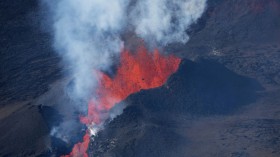As the climate changes and the Arctic landscape shifts, more and more whales and a greater number of whale species are being seen in the Bering Strait, according to a new three-year study.
Researchers used underwater microphones to track whales by their sounds as they passed through the waters of the Bering Strait, revealing that as Arctic ice melts, the regions is seeing a growing number of whales, as well as ships.
"It's not particularly surprising to those of us who work up in the Arctic," said Kate Stafford, an oceanographer with the University of Washington's Applied Physics Laboratory. "The Arctic seas are changing. We are seeing and hearing more species, farther north, more often. And that's a trend that is going to continue."
As part of a US-Russia collaboration, Stafford and her colleagues placed microphones underwater and recorded activity in summer and early winter from 2009-2012. They recorded Arctic beluga and bowhead whales was they migrated from the Arctic south to spend winter in the Bering Sea. They also detected large pods of sub-Arctic humpback, fin and killer whales traveling north through the Bering Strait to feed in the Chukchi Sea.
"These animals are expanding their range," Stafford said. "They're taking advantage of regions in seasons that they may not have previously."
The microphones also recorded ships traveling through now ice-free international shipping lanes in the area, which the researchers said poses the risk of noise pollution as well as the increased risk of ships colliding with whales.
"Marine mammals rely primarily on sound to navigate, to find food and to find mates. Sound is their modality," Stafford said. "If we increase the ambient sound level, it has the potential to reduce the communication range of cetaceans and all marine mammals."
Stafford presented her research Wednesday at the American Geophysical Union's Ocean Sciences meeting in Honolulu.
"The Arctic areas are changing," Stafford said. "They are becoming more friendly to sub-Arctic species, and we don't know how that will impact Arctic whales. Will they be competitors for food? Will they be competitors for habitat? Will they be competitors for acoustic space, for instance these humpbacks yapping all the time in the same frequency band that bowheads use to communicate? We just don't know."
© 2024 NatureWorldNews.com All rights reserved. Do not reproduce without permission.





